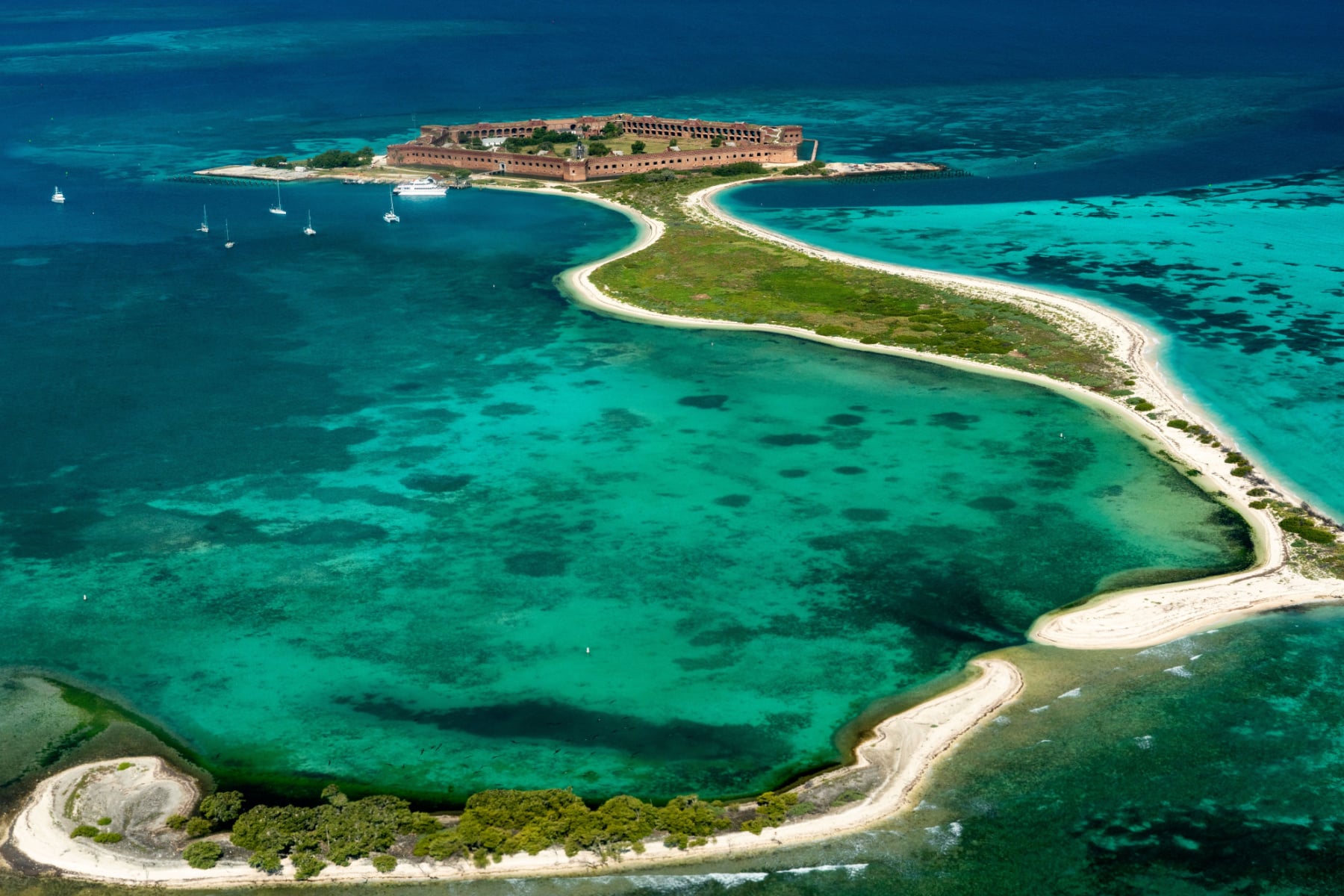
Article Overview: Dry Tortugas Activities
Dry Tortugas National Park takes you 70 miles off the coast of Key West to a collection of islands and a park that’s 99% water. It’s a land of massive coral reefs, scuba diving delights, and shipwrecks to explore. Dry Tortugas snorkeling is unparalleled.
From the fascinating ferry to Dry Tortugas from Key West to Dry Tortugas snorkeling to history above and below the water, you can’t afford to leave this national park off your bucket list.
The seven islands sit at the meeting point of the Atlantic Ocean, the Caribbean Sea, and the Gulf of Mexico. Once a major shipping channel, these small islands had a big task to protect the passageway.
More than three million people visit Key West each year, yet just 80,000 or so make their way 70 miles west to the watery wonderland of Dry Tortugas.
You’ve likely heard that Dry Tortuga is one of the least visited parks. While that’s true, with fewer than 80,000 people visiting in 2022, it’s also a national park that is in high demand, with Key West ferry rides to Dry Tortugas booked months in advance.
Since the ultimate visit to Dry Tortugas includes a mix of vendors and guidance from different sources, we’ve compiled it all in one easy-to-read article.
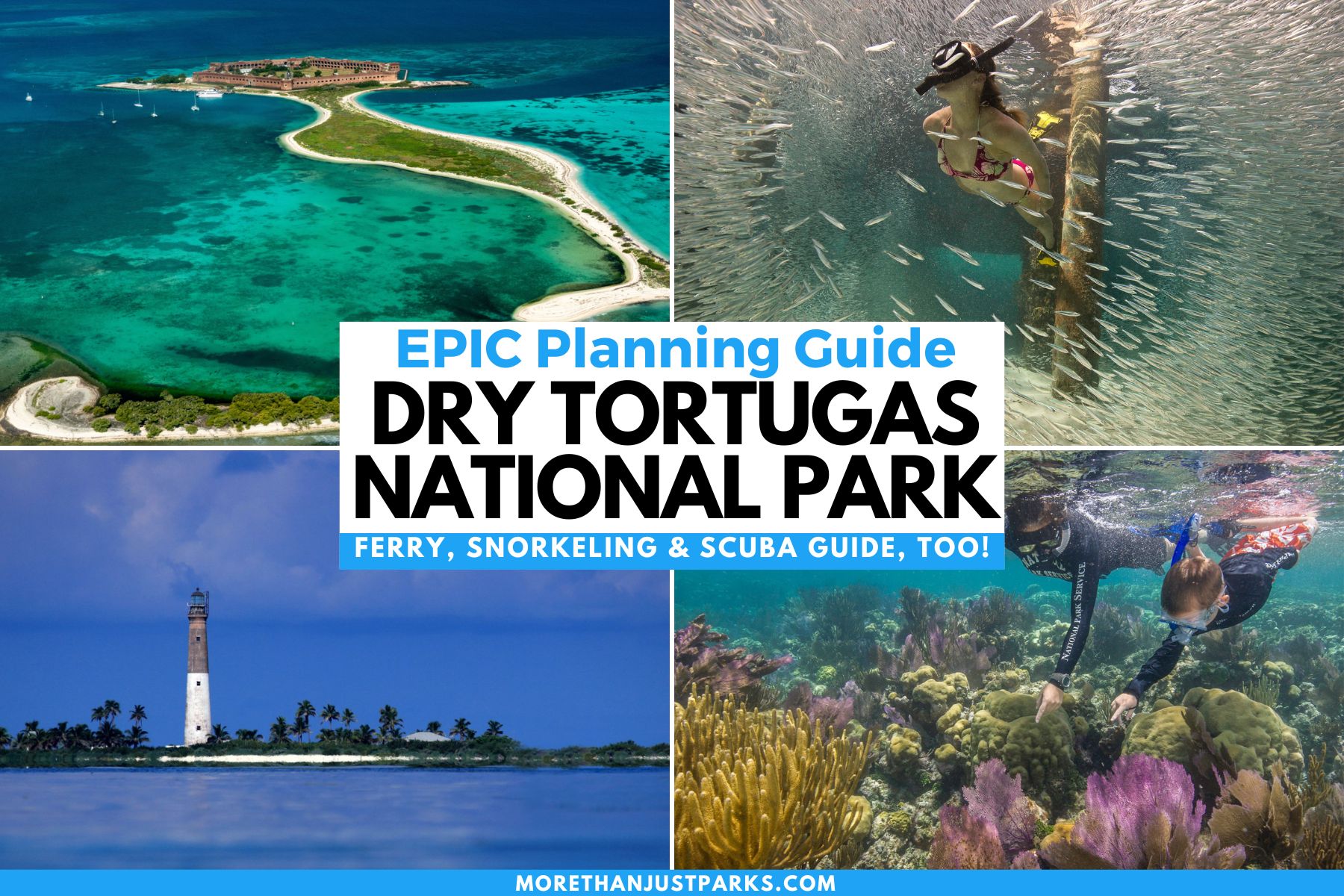
Dry Tortugas Snorkeling and Other Activities
Table of Contents: Dry Tortugas Activities
Table of contents: Dry Tortugas Activities
- Dry Tortugas Snorkeling and Other Activities
- Dry Tortuga Key West Access
- Dry Tortugas Tour Layout
- Top 10 EPIC Things to Do in Dry Tortugas
- 13. Spot Sea Turtles
- 12. Walk Between Garden Key and Bush Key
- 11. Become a Birder
- 10. Island Camp Under the Stars
- 9. Kayak Around the Islands
- 8. Snorkel Little Africa
- 7. Explore the Moat Wall (Above and Below Water)
- 6. Tackle Texas Rock
- 5. Fascinating Fort Jefferson
- 4. Circle Pulaski Shoals
- 3. Dive the Windjammer Wreck
- 2. Snorkeling at Night
- 1. Liveabord Boat Trip
- Things to Know Before You Visit Dry Tortugas National Park
- FAQ – Dry Tortugas National Park Activites
- Summary of Things to Do in Dry Tortugas
- Pin Dry Tortugas Snorkeling and Activities

Dry Tortuga Key West Access
Dry Tortugas sits among the Florida Keys Reef System, so 99% of the park is turquoise-kissed water. Getting there is easy if you know where to look. Let’s make it easy.
Most importantly, you need to get to Key West. If you fly into Miami International Airport and rent a car, you’ll have a 160-mile drive that will take three hours without stopping.
Another option is to fly into Southwest Florida International Airport in Fort Myers and take the Key West Express boat to Key West for access to Dry Tortugas. You’ll spend $185 for each adult to get a roundtrip ride.
TRAVEL TIP: Book that Key West Express at least eight days in advance and travel Monday through Thursday to lower the price to $155.
Key West to Dry Tortugas
Once you’re in Key West, you’ll have three options to get to Dry Tortugas. First, take a boat ferry to Dry Tortugas. Second, you can take a seaplane flight. Thirdly, you can rent a charter or tour company excursion.
Let’s look at those costs.
- Key West to Dry Tortugas Ferry: Expect to spend between $200 – $240 for the roundtrip, with additions like camping and kayaking optional. The Yankee Freedom Ferry is by far the most popular.
- Seaplane to Dry Tortugas from Key West: You can also fly into Dry Tortugas, with costs between $450 and $800, depending on how long you will stay.
Boater Info: If you have your own boat, you can use that to get to Dry Tortugas National Park. It’s important to know how to get a boat permit and the boating rules, so here’s some help with that. Mooring and landing spots are limited.
Finally, you should know that there are no cars allowed on Dry Tortugas, and the best way to explore all aspects of the water and land is with your own boat. Ferries can sell out up to A YEAR IN ADVANCE, so a private boat gives you more flexibility, too.
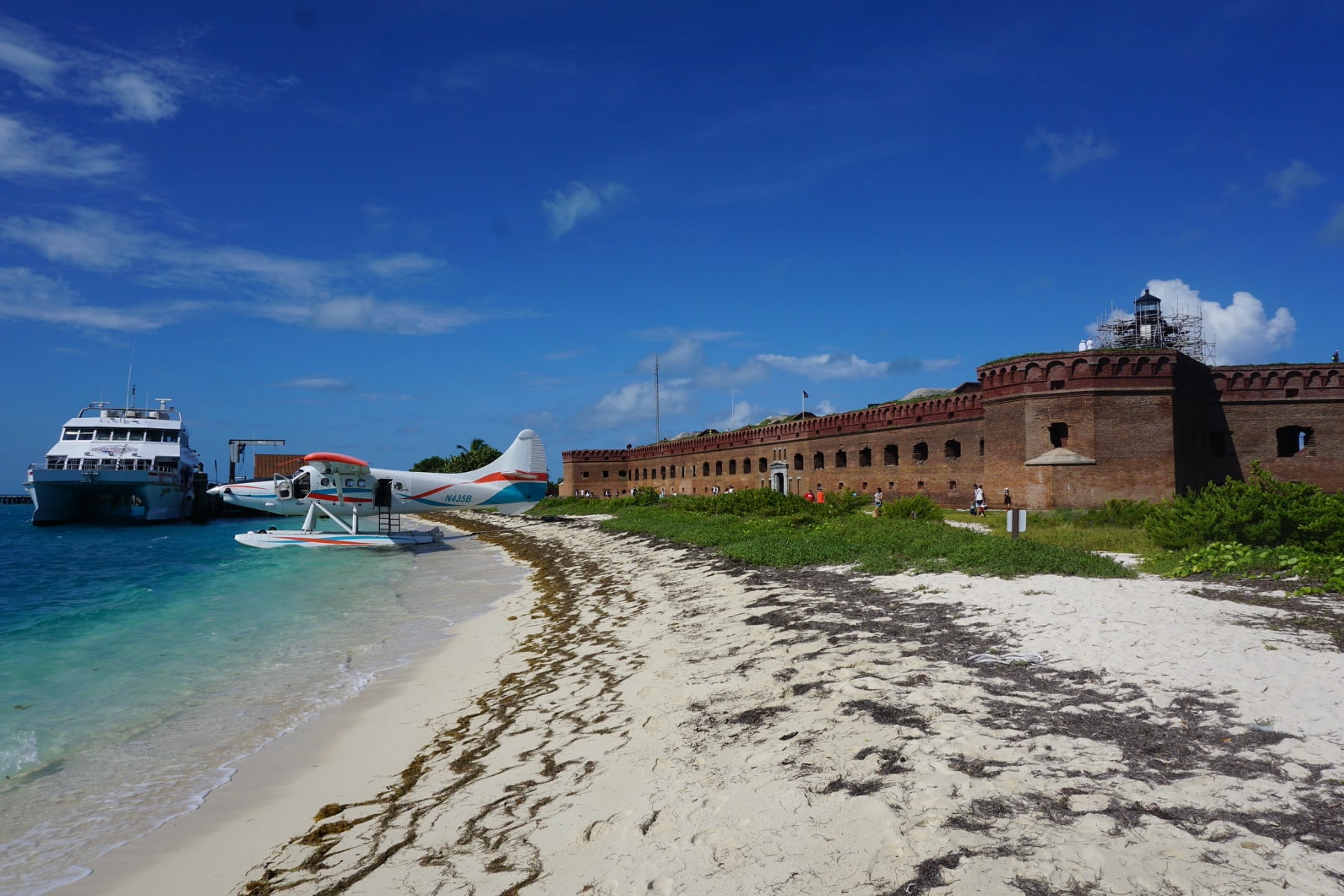
Dry Tortugas Tour Layout
Before we can get to the things to do in Dry Tortugas National Park, it’s helpful to know the lay of the land and water access points. While the park is 100 square miles, just 1% of that is above the water.
In addition, four of those keys are closed to visitors year-round to protect the habitat.
- Garden Key: Home to historic Fort Jefferson.
- Loggerhead Key: The largest island in the park, you can only access this area by kayak or private boat. Shipwrecks and Dry Tortugas snorkeling are popular.
- Bush Key: An undeveloped slice of subtropical heaven open from October through January. It’s otherwise closed for rare birds to nest.
- Long Key: Closed to the public.
- East Key: Closed to the public.
- Hospital Key: Closed to the public.
- Middle Key: Closed to the public.
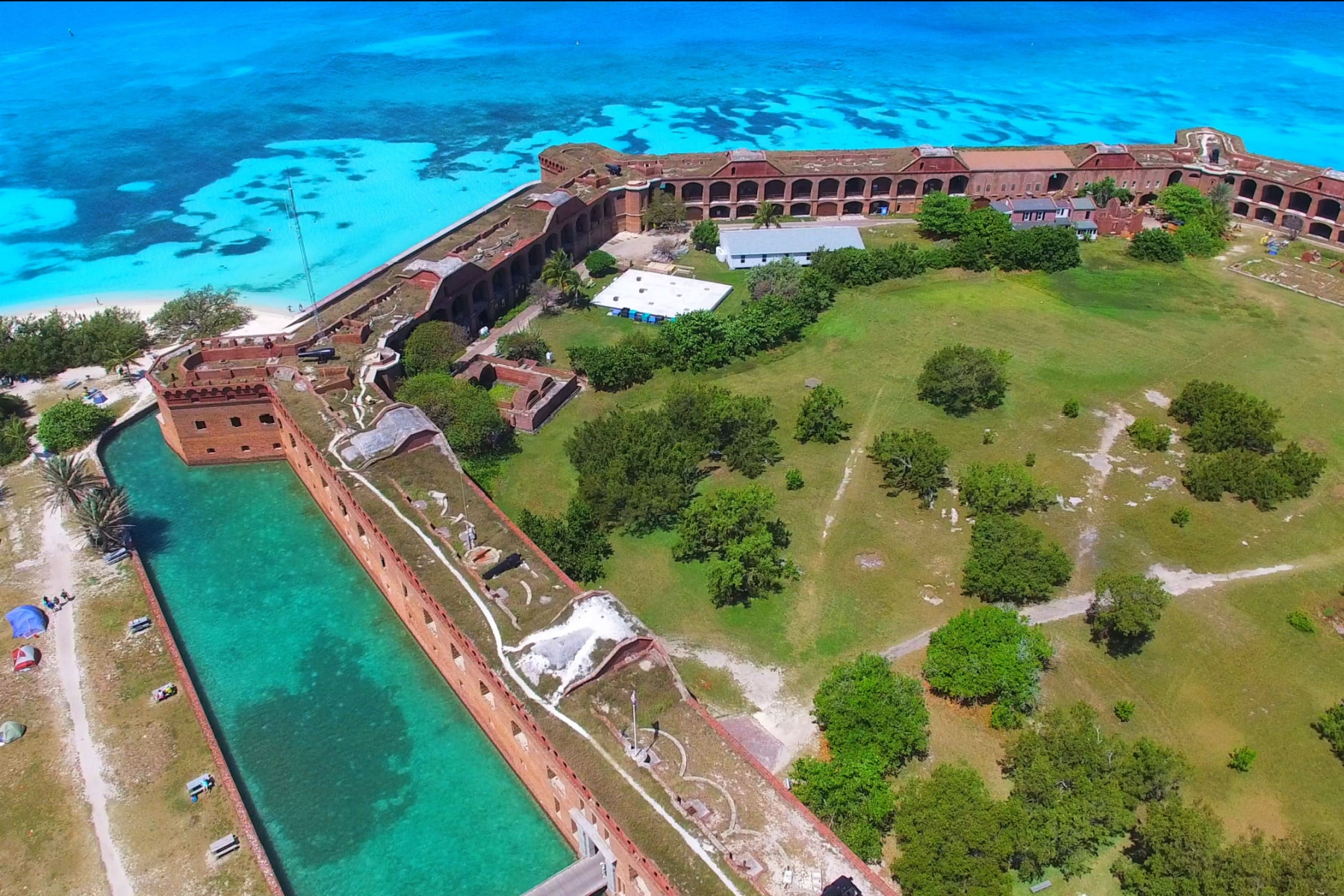
Top 10 EPIC Things to Do in Dry Tortugas
13. Spot Sea Turtles
The Dry Tortugas first went by the name “Las Tortugas.” Due to the abundance of sea turtles, some quite large, Ponce de Lion named the islands after those animals in 1513. The name was adjusted to “Dry Tortugas” so ship captains would know there was no drinkable water on the island.
Those same turtle species roam today, but it’s on the list of epic things to do in Dry Tortugas since it’s a rare lucky traveler who sees part of this natural wonder. The best time to see sea turtles in Dry Tortugas is in the summer.
Pregnant females crawl out of the sea and lay eggs, up to 100 of them, after digging a nest above the high water mark. She returns to the sea, and the eggs are left alone. About 60 days later, the eggs hatch around the same time. Then, en masse, the hatchlings wiggle their way back to the sea, where they will live in seaweed for a few years.
The best places to see sea turtles in Dry Tortugas National Park are:
- On the boat ride between Key West and Dry Tortugas.
- Snorkeling in Dry Tortugas around the Fort Jefferson moat.
- Loggerhead Key, on the beach and in the water. You will need a kayak or boat to get to Loggerhead Key, as it’s three miles from Garden Key.
Never disrupt a sea turtle nest or block a turtle from accessing the water.
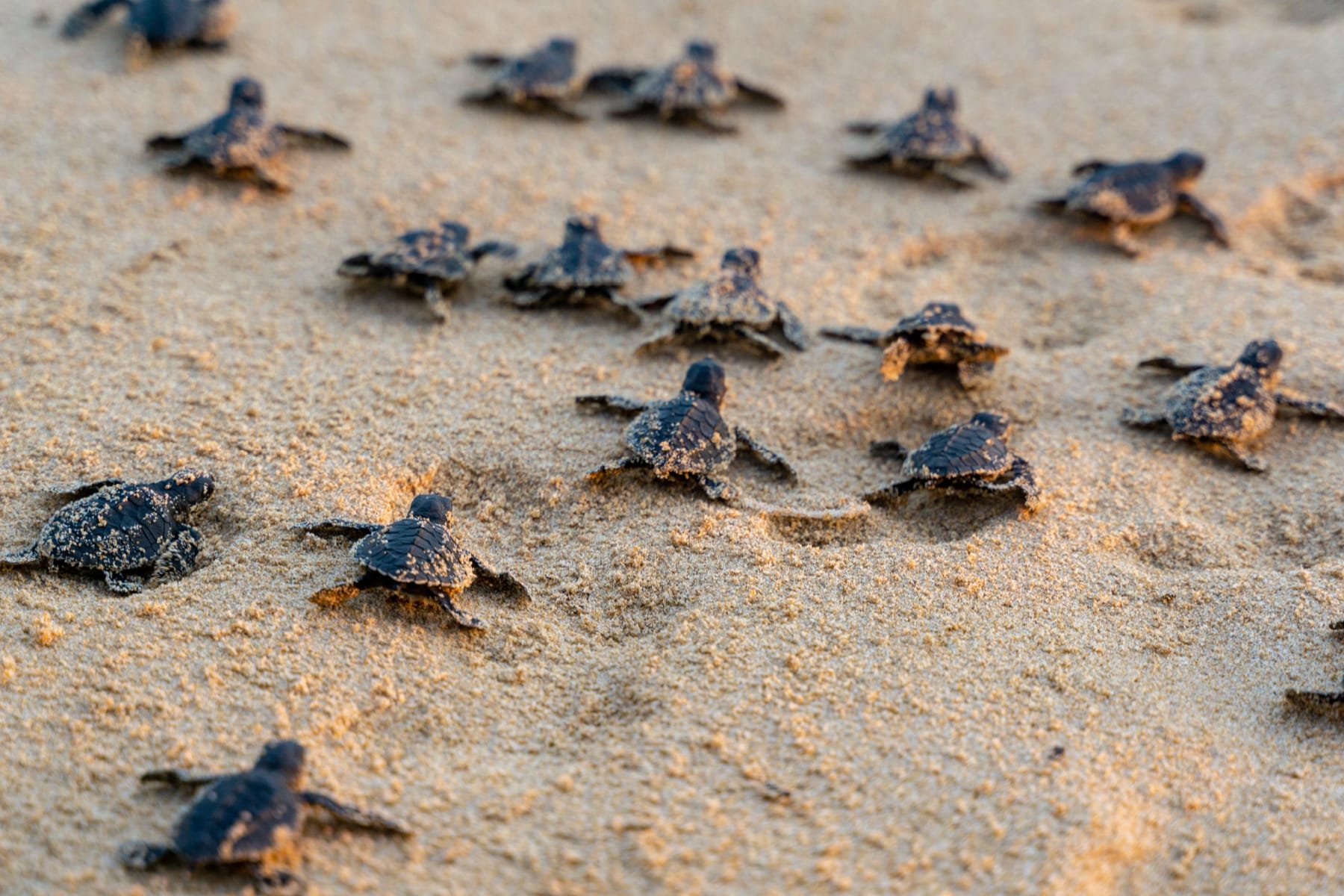
12. Walk Between Garden Key and Bush Key
This is one of the best things to do in Dry Tortugas because you don’t even know if it will exist until you get there.
A stretch of sand usually connects Garden Key, home of Fort Jefferson, and Bush Key. All it takes is one big storm or enough erosion to move that land bridge underwater. When that happens, you can still access Bush Key outside of the nesting season, but you’ll need to swim or kayak to get there.
The walk around Bush Key is a natural zoo of birds, sharks, and sea turtles, all in less than a mile and a half.
Beachcombing Alert: To find the best shells, scour the north end of the island, as that’s where the biggest waves hit. Seashell collecting is not allowed at Dry Tortugas National Park. Only National Seashores would have allowances and limits for collecting.
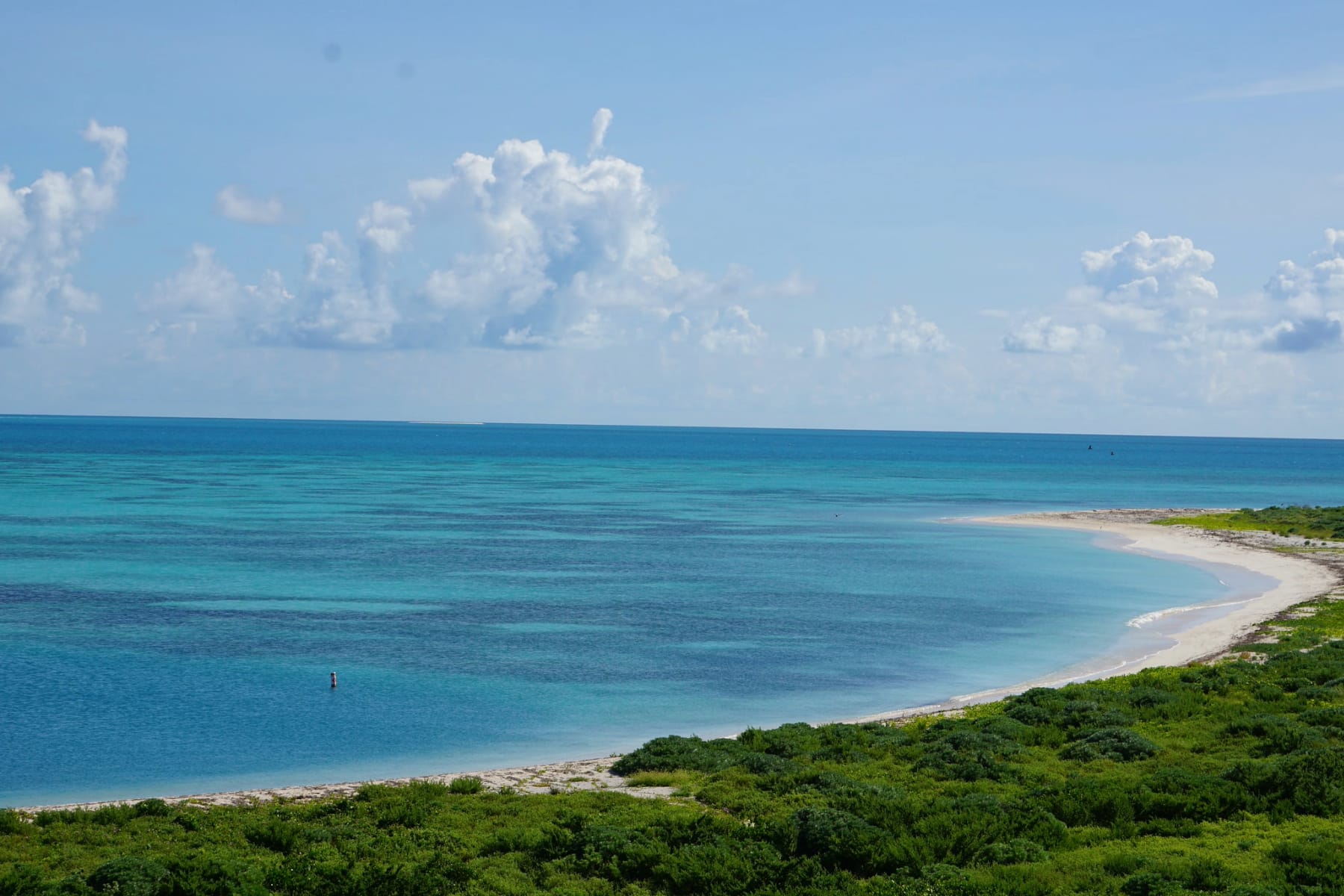
11. Become a Birder
Spring migration through Dry Tortugas brings a “spring break” of sorts for nearly 300 species of birds, including the Magnificent Frigatebird. Dry Tortugas offers the only nesting spot for these birds in the United States.
I never thought much about birds until I moved to Florida, and I became infatuated. That includes the two Sandhill Cranes that woke me up daily in my backyard (I named them Loud and Louder) to the Roseate Spoonbill offering an explosion of my favorite color, pink. When you have the right guide, birding becomes fascinating.
You’ll get a chance to track more than 300 species of birds here, as you can see in the (downloadable) list below. Bush Key becomes overrun with Sooty Terns and Brown Noddies during migration. That’s why the island is closed to visitors for half of the year.





A viewing platform stands on Garden Key to get a look at this epic aerial adventure.

10. Island Camp Under the Stars
Camping is one of the best things to do in Dry Tortugas for anyone who truly wants to unplug and be surrounded by nature. You won’t worry about crowded campsites because the options are limited here to a lucky group of 10 campsites a night.
The campsites sit on the sand outside Fort Jefferson on Garden Key.
The most important things to know about camping in Dry Tortugas National Park include the following:
- You can only take a designated camper ferry from Key West to Dry Tortugas through Yankee Freedom.
- Campers can’t use seaplanes due to the extra weight of the equipment.
- NO SUPPLIES are available in Dry Tortugas. From water to food to kayaks, you bring everything with you.
- You MUST have a tent to camp in due to the wildlife on the island.
- You cannot reserve a campsite. They are first come, first served, but the bookings on the Key West ferry will give the headcount. There is an overflow camping area.
The Yankee Freedom Dry Tortugas campsite ferry can be booked up to a year in advance, so plan far ahead if this is one of your preferred things to do in Dry Tortugas. It’s worth the wait!
CAMPING FACT: Just 10% of the people who visit Dry Tortugas National Park stay overnight at the campgrounds as of 2022.
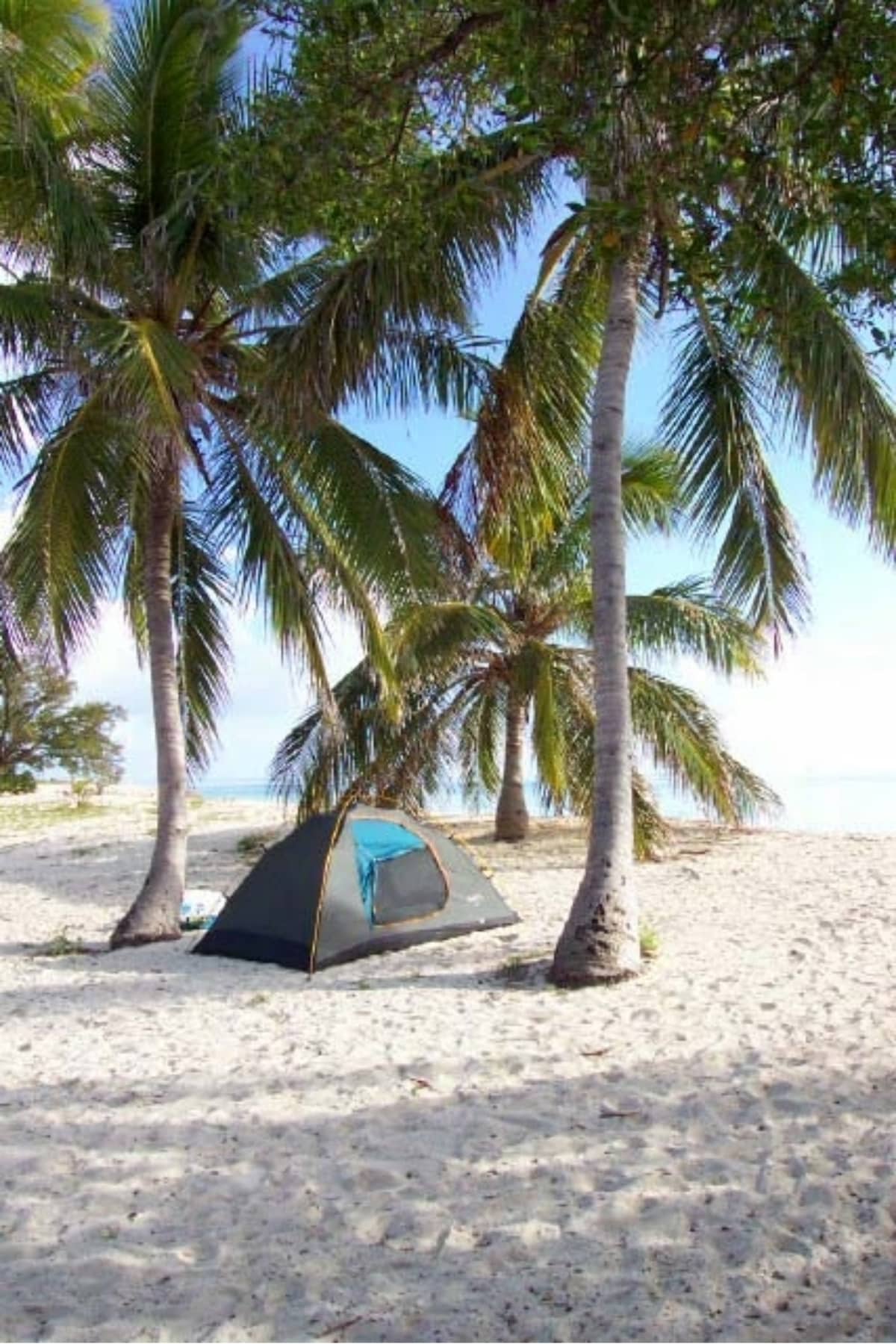
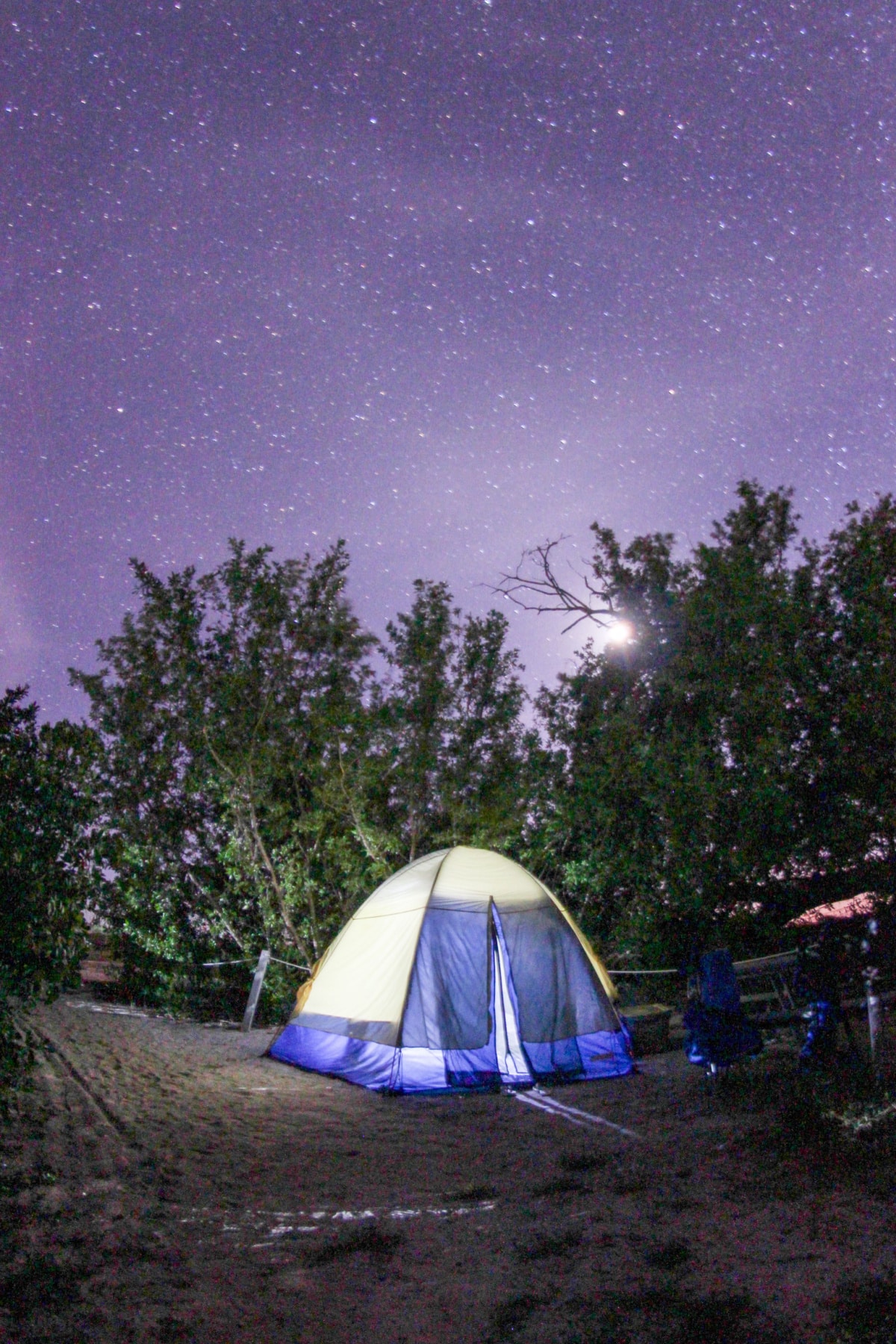
9. Kayak Around the Islands
Unlike many of the kayaking locations in Key West, paddling around Dry Tortugas National Park takes a lot of planning and a little luck.
The Yankee Freedom Ferry only has room for a handful of kayaks during the trip from Key West to Dry Tortugas. For the most part, only campers are allowed to bring kayaks. You can rent a kayak in Key West or bring your own, but the Yankee Freedom in Key West doesn’t provide kayaks.
Once you’re there, you can take easy paddle trips around Garden Key, Bush Key, and Long Key. However, you must stay 100 yards offshore of the latter two.
More experienced paddlers choose to explore the three-mile paddle of open ocean to Loggerhead Key. Beginners should not attempt this, but I can’t think of a better reason to start getting paddling experience now. Once you arrive at Loggerhead Key, you get the bulk of the largest island in Dry Tortugas nearly to yourself.

8. Snorkel Little Africa
If you can get to Loggerhead Key, and we strongly recommend that you do, you can take one of the easiest yet most exhilarating snorkeling Dry Tortugas adventures.
The clear water beckons you to explore the shallow reef shaped similarly to the continent of Africa. Little Africa is one of the best places for children to snorkel at Dry Tortugas as well. The water is no more than eight feet deep most of the time.
Little Africa is easy to find because it’s located right off a designated swim zone.
Need snorkeling gear for Dry Tortugas? You can bring your own, rent it in Key West, or rent from the ferry or seaplane from Key West to Dry Tortugas. Scuba gear is not allowed on the ferry.



7. Explore the Moat Wall (Above and Below Water)
Fort Jefferson on Garden Key in Dry Tortugas includes a protective moat wall, mostly to protect from the turbulent seas.
Walking the moat wall offers a great view of the fort and the creatures in the water. A designated swimming beach is at the southwest corner beyond the moat wall.
Moat Wall Snorkel Spots
- Along the edge of the moat wall.
- About 75 yards in the water
- South Wharf Ruins
- North Wharf Ruins
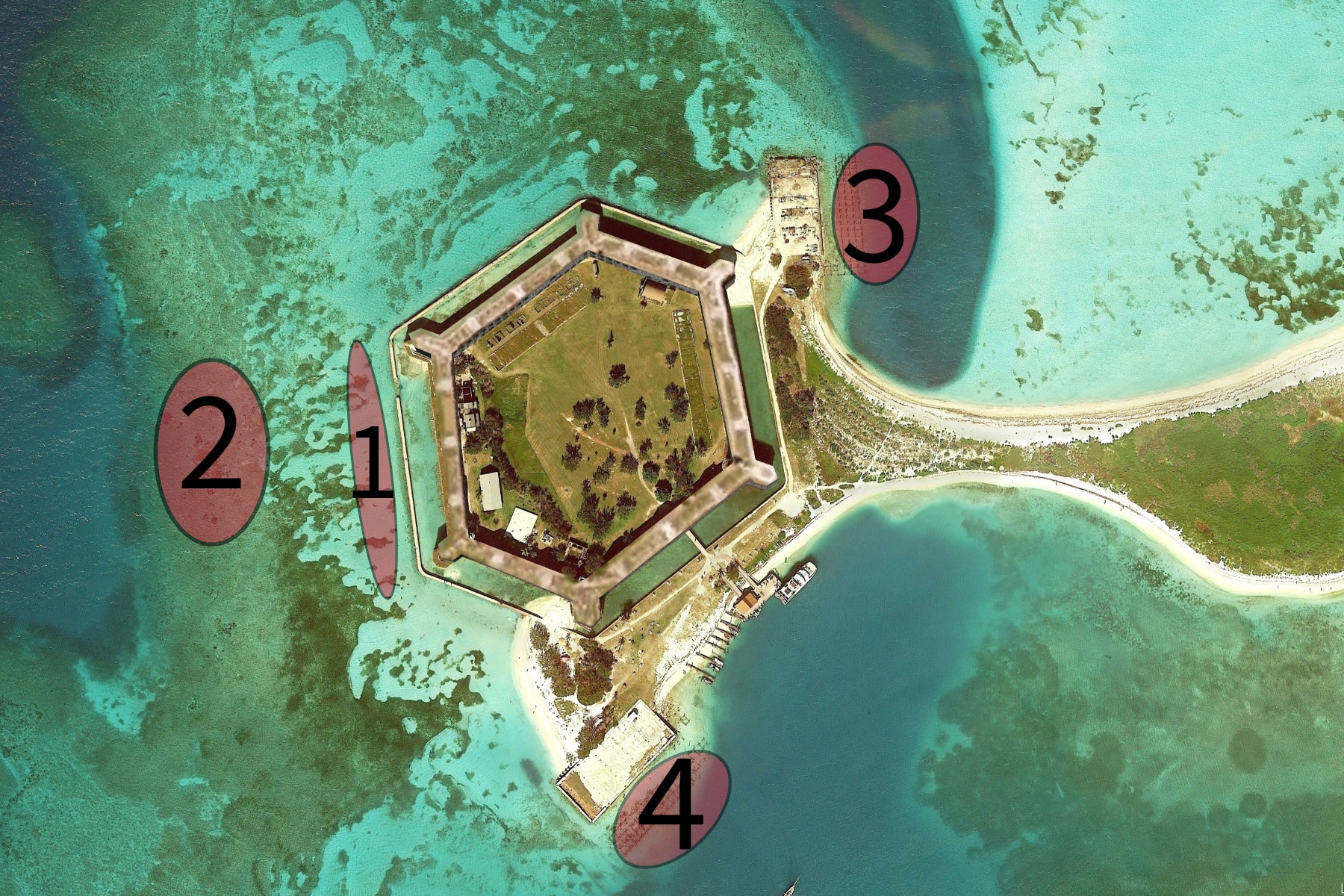
The wharf ruins include sharp, rusted metal and coral reefs in a tight space. Explore these areas only if you are an experienced snorkeler.
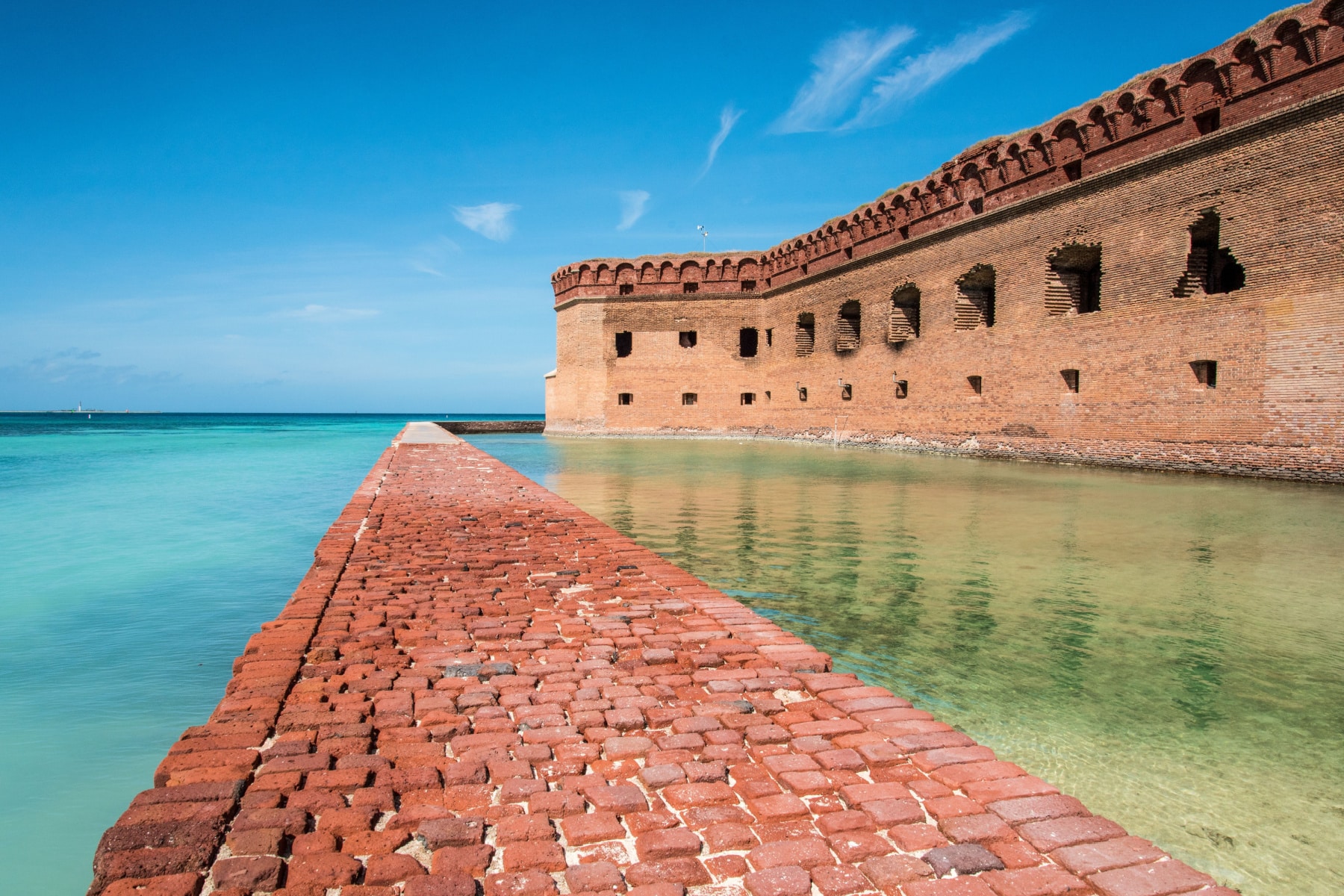
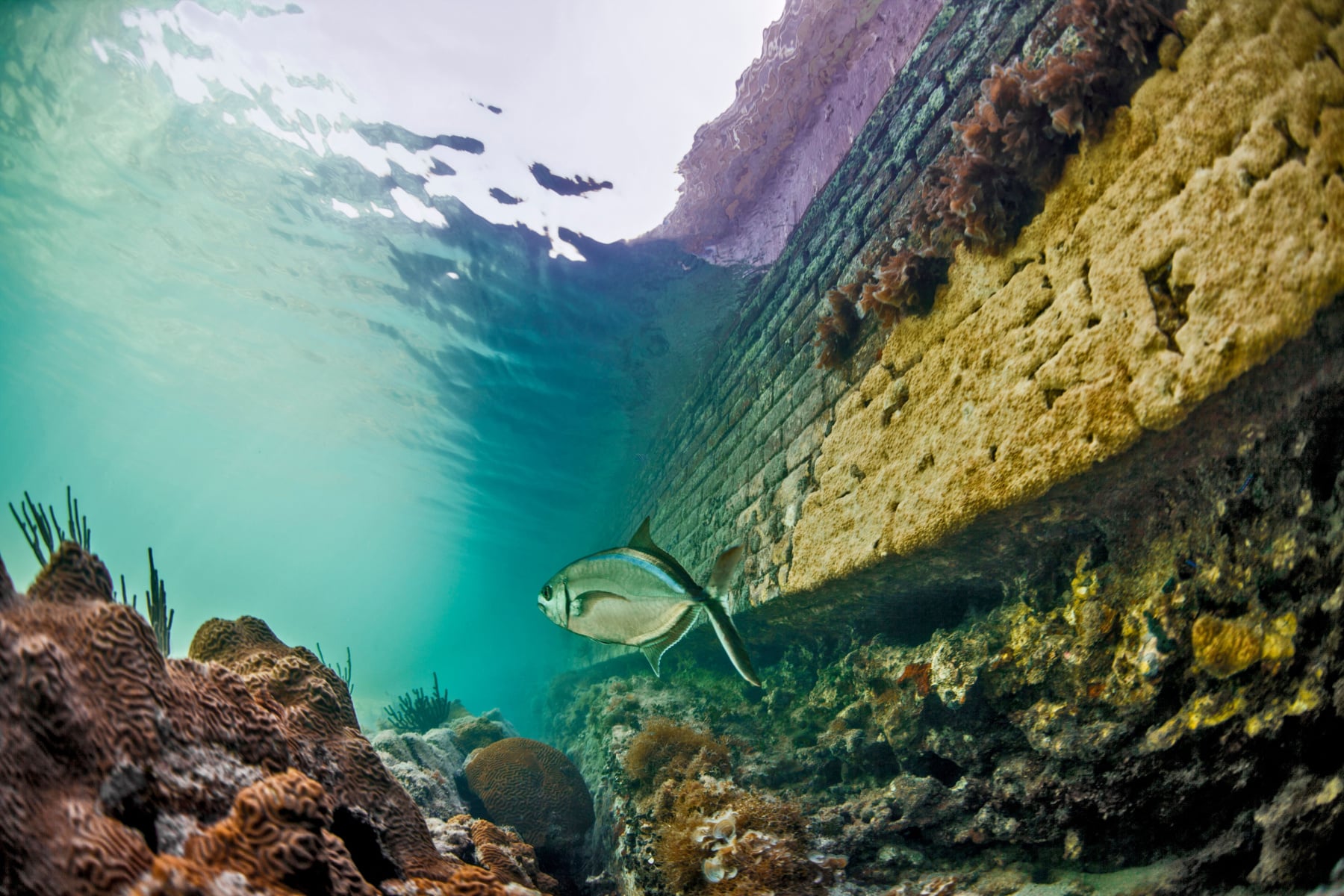
6. Tackle Texas Rock
This daring dive in a remote section of watery Dry Tortugas offers an abundance of sea life thanks to a mound that rests on top of a deep reef. During most dives, you’ll slip into the water through schools of fish just above the coral.
Head to the north side of the reef for deep-water sea fans. Reports of black coral in this area might encourage you to explore some of the crevices.
This is a full-day dive trip, and the mound is surrounded by sand, giving you an underwater beach adventure.
Dive Details: Scuba diving equipment is not allowed on the ferry or seaplane, so you’ll need a charter boat or a tour guide. Finz Dive Center offers the only park-sanctioned dive trips for Dry Tortugas.

5. Fascinating Fort Jefferson
Fort Jefferson is a massive coastal fortress that was built starting in 1846 and continued for over three decades. The powerful position along a major shipping channel offered a rest stop and refuge from storms in the deep-water strategic spot.
During the Civil War, Fort Jefferson served as a Union military prison. It housed notable prisoners, including Dr. Samuel Mudd, who treated John Wilkes Booth after the assassination of President Lincoln.
Over the years, the fort’s role diminished, and it was abandoned in the late 1800s. In 1935, the collection of islands was designated as a National Monument, with National Park status not arriving until 1992.
Fort Jefferson Fun Fact: The fort was never completed, despite its valuable uses in two wars and through America’s infancy. You’ll learn more about that on the tour.
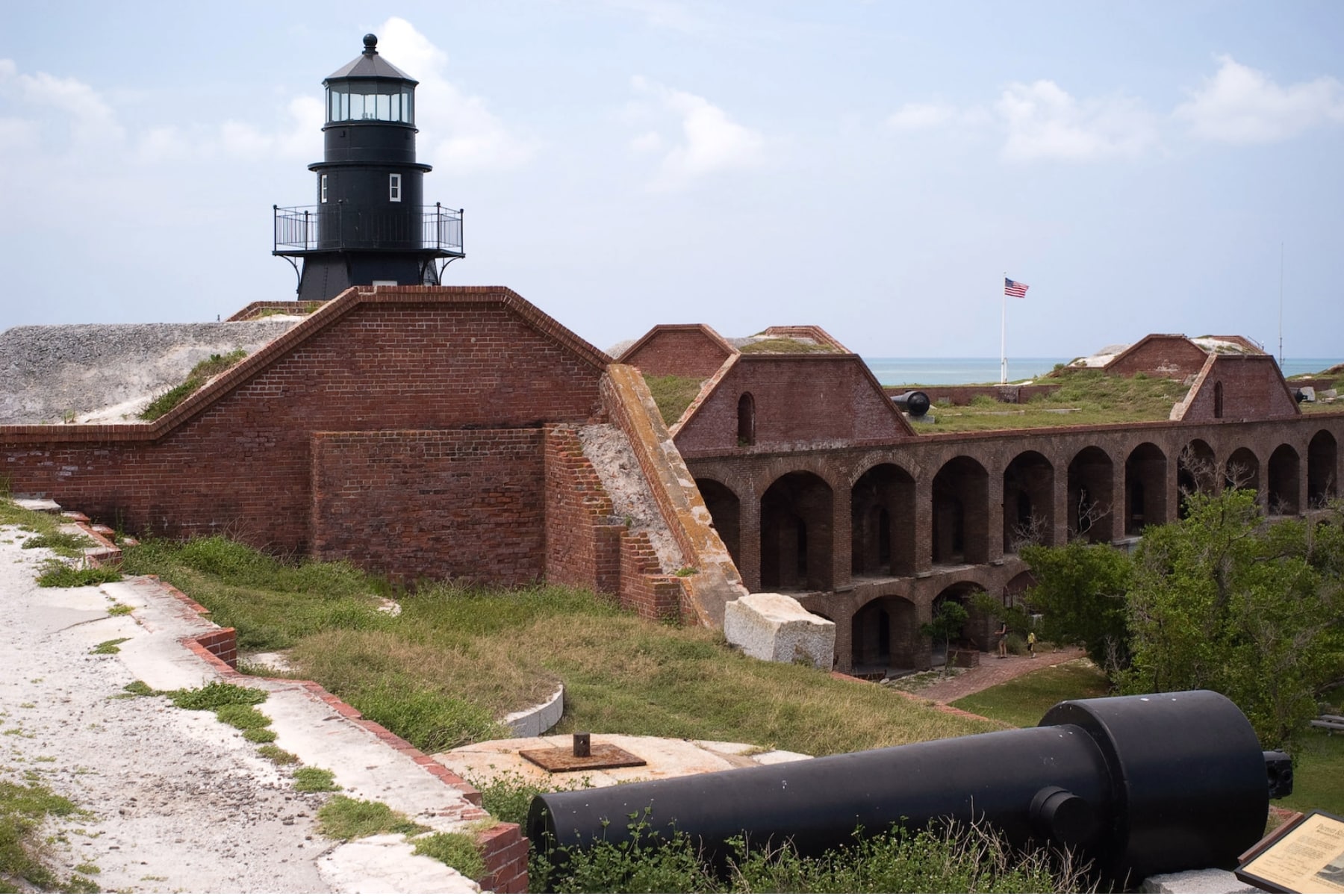
4. Circle Pulaski Shoals
Dry Tortugas snorkeling at the eastern edge of the park is found at Pulaski Shoals and marked by a light tower. You’ll be snorkeling at one of the most treacherous spots for shipwrecks. The coral here sits in shallow water, and debris from shipwrecks is mixed in with marine life.
More experienced divers can head 80 feet away from the shallows and see a dramatic drop in the reef. You’ll be among the most wild creatures of the open sea, including several varieties of sharks and massive grouper.

3. Dive the Windjammer Wreck
Of all the shipwrecks in this important passageway, the wreckage nicknamed The Windjammer sits well-preserved in skeletal form –a testament to the durability of iron ships. This ghost ship of sorts sank on January 22, 1907, after a brave crew of 19 tried to save her.
As shown in the photo below, the outline of the wreck is easily seen from above.
The wreckage is a good half mile from Loggerhead Island but sits in shallow enough water that beginning divers and regular snorkelers will get quite a show.
The Windjammer, aka “Avanti” History: Here’s a great summary of the ship’s history and the final voyage through the infamous “Ship Trap” of this passageway near the keys. Everyone survived this shipwreck, and all supplies were removed. Her pieces still rest across the shallow waters and are somewhat exposed at low tide.
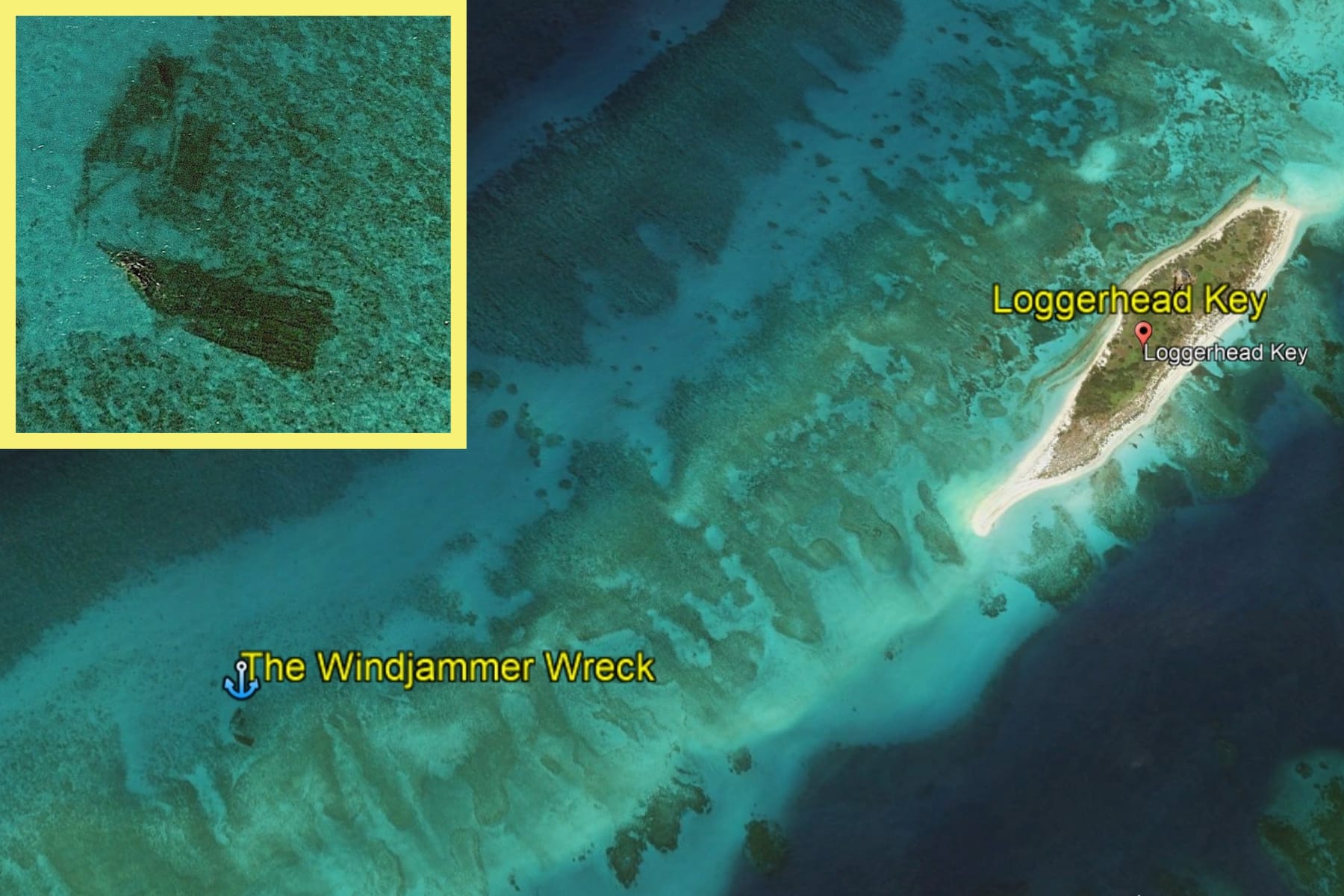
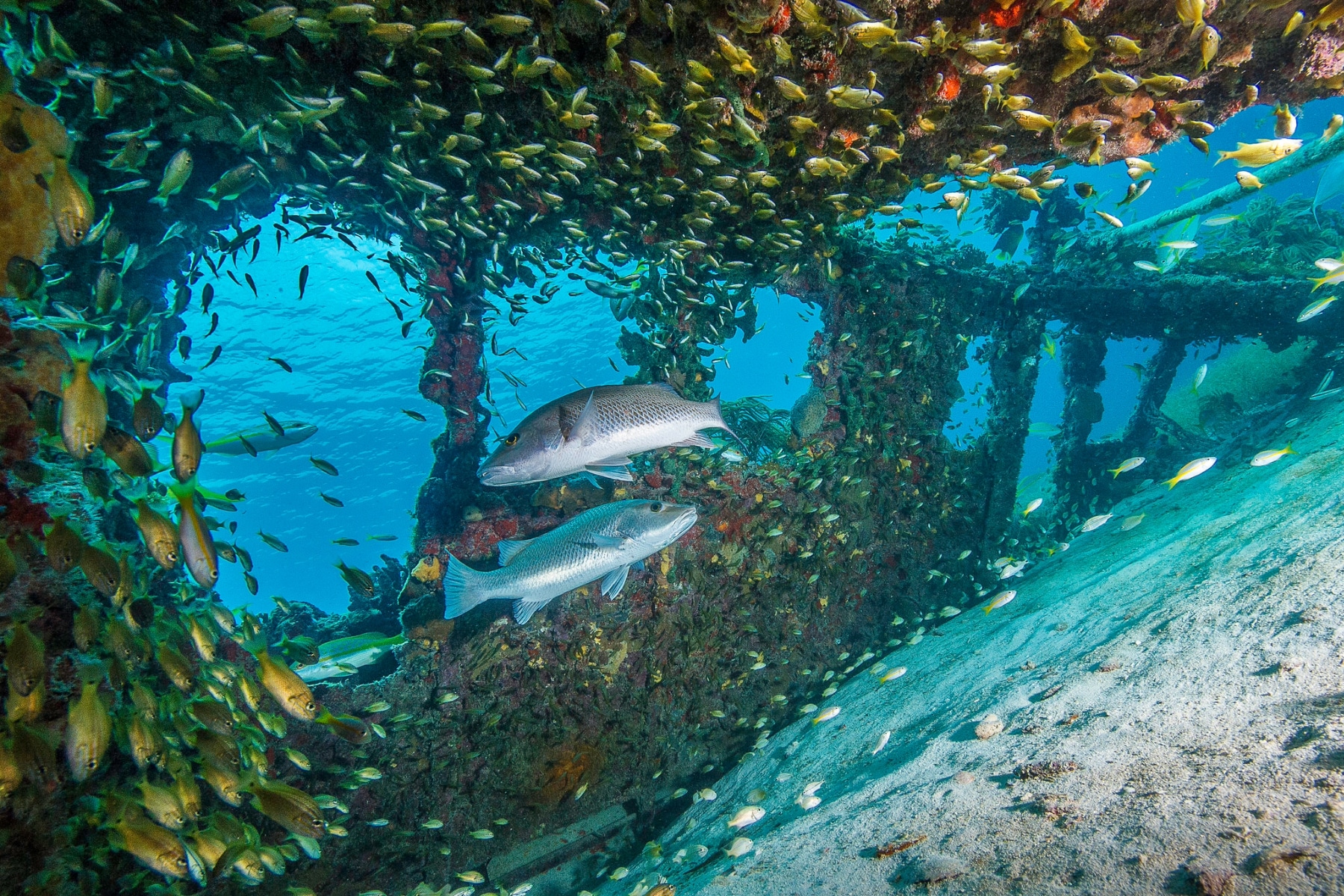
2. Snorkeling at Night
We highly recommend planning this experience because you’ll see a whole different underwater world when you go snorkeling in the Dry Tortugas at night.
Night snorkeling the Fort Jefferson moat wall brings you closer than you can ever get during the daytime to some of the unique underwater species. Fish aren’t as active, and some night lovers like octopuses, squid, and lobsters are often around the wall.
There are few snorkeling options in the world that give you such an intimate look at the overnight activity around coral reefs. The National Park Service tells us this activity is safe enough for kids who are comfortable in the water.
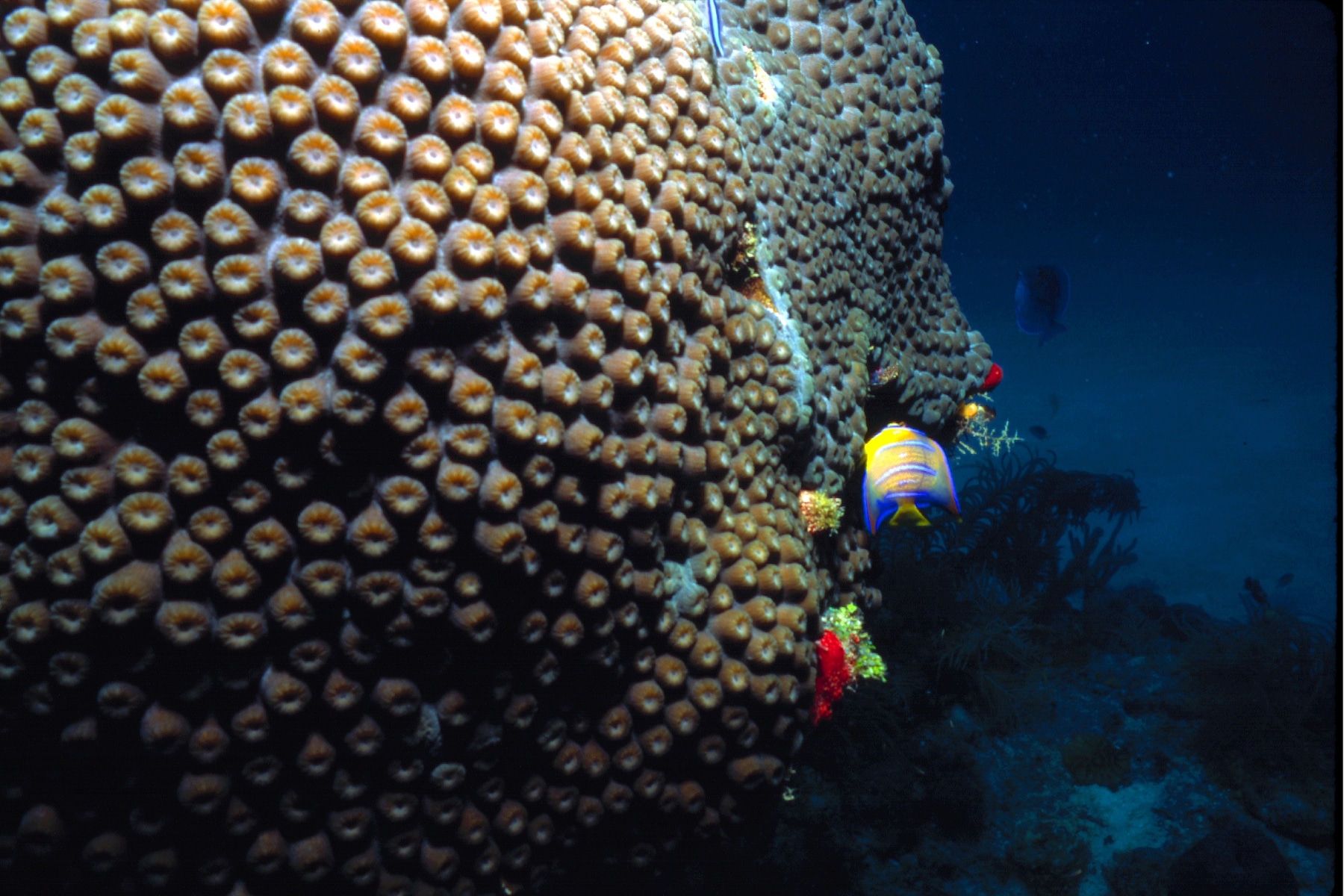
1. Liveabord Boat Trip
You can skip the hotel and choose to stay on a boat for multiple nights with more snorkeling trips, fishing spots, and dive opportunities than you’ll get anywhere else.
Adventure Watersport Charters puts you in charge of the schedule. They provide the boat, accommodations, meals, and rental equipment for whatever activity you choose. You can stay on board for up to four nights and do up to six dives or snorkeling trips per day.
As one of the only permitted charter boats in Dry Tortugas National Park, this is a wonderful option to stay in the park but still on the water.

Things to Know Before You Visit Dry Tortugas National Park
Entrance Fees
$15 per person, valid for seven days. Those 16 and younger are free. If you want to purchase the America the Beautiful Pass, please do so online because it’s not available on-site at this remote park. It’s a great pass to have since it gives access to more than 2,000 public lands.
Sunscreen
Use reef-friendly sunscreen like this one. You’ll need it year-round in Dry Tortugas.
Insect Repellent
Bring bug spray, and we suggest this one or this one if you’re a DEET person. Both are eco-friendly.
Guide Book
The Best Guidebook for Dry Tortugas National Park is this one.
Map
National Parks Checklist Map: This beautiful National Parks Checklist Map can be ordered to your house. There’s also this framed national parks map.
Where to Stay in Dry Tortugas National Park
Where to Stay: This is our favorite hotel in/around Dry Tortugas National Park.
Critical Planning Information
Dry Tortugas offers many activities for true adventurers. Many activities aren’t for beginners. Most activities require extensive planning.
- Scuba Certified: Most scuba diving tours will require Open Water Diving certification. Check with your preferred vendor.
- Snorkel Gear: Most tours will provide snorkel gear. Ferries will also rent them out. You don’t have to buy snorkel gear, but you can’t rent it on the keys. Plan ahead.
- Paddle Sports Permits: All water vessels require a boating permit. That includes SUPs and kayaks. As noted above, only a limited number of kayaks can go on the Yankee Freedom ferry to Dry Tortugas from Key West. NO RENTALS ARE AVAILABLE ON THE ISLAND.
- Ranger Check-Ins: Before you enter the water in any capacity, check with a park ranger. Explain your plans and ask about extra safety steps and guidance.
- Survival Skills: You will have no mobile phone service anywhere in Dry Tortugas National Park. A rescue could be hours away if you get in trouble. Never go diving, snorkeling or kayaking alone. Review the park’s safety guidance. For example, you don’t want to get to the park for kayaking only to be without a VHF radio.
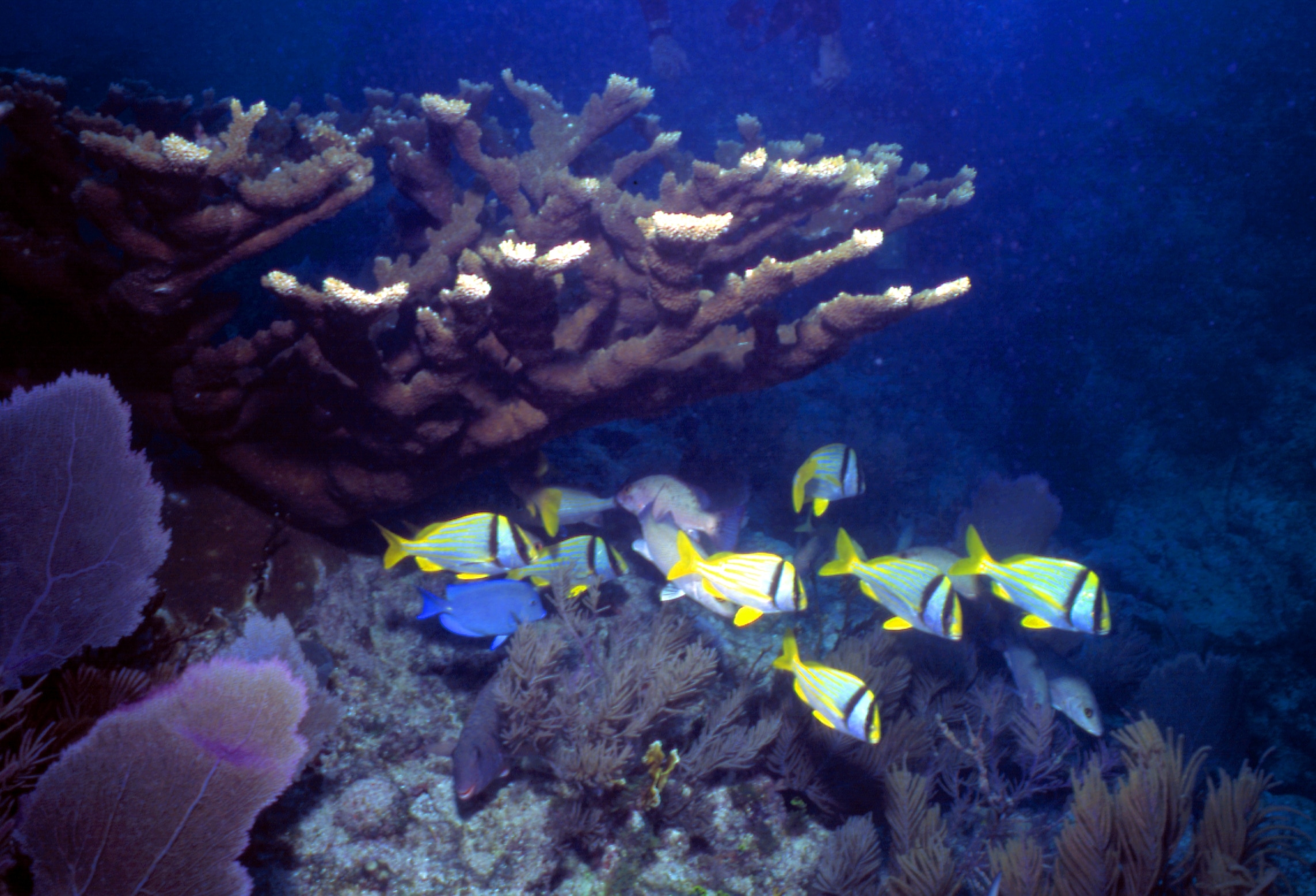
FAQ – Dry Tortugas National Park Activites
Dry Tortugas is a remote location with limited access points and a finite number of people who can board the ferries or planes each day from Key West. The price to visit Dry Tortugas is comparable to visiting any other tropical paradise. You’ll also pay for the specific activities that aren’t part of the National Park Service.
Yes, several varieties. The most common is the Nurse Shark, which is known as the most docile of the shark family. In fact, sharks come here to mate each year, and there’s a protected section of the park water to study these apex predators. That said, shark attacks can and do occur rarely.
Yes, the Hurricane Season runs from June 1 through November 30 each year. If there is potentially life-threatening weather, the ferries and seaplanes won’t run, and the park will close. Plenty of advanced warning comes with tropical storms and hurricanes. Pay close attention to the National Hurricane Center and Park Conditions. Even after a hurricane, damage can keep the park closed for days or weeks. In fact, it was Hurricane Irma that left the gaping hold in the moat wall. 
Summary of Things to Do in Dry Tortugas
- Liveaboard Boat Trip
- Snorkeling at Night
- Dive the Windjammer Wreck
- Circle Pulaski Shoals
- Fascinating Fort Jefferson
- Tackle Texas Rock
- Explore the Moat Wall (Above and Below Water)
- Snorkel Little Africa
- Kayak Around the Islands
- Island Camp Under the Stars
- Become a Birder
- Walk Between Garden & Bush Key
- Spot Sea Turtles
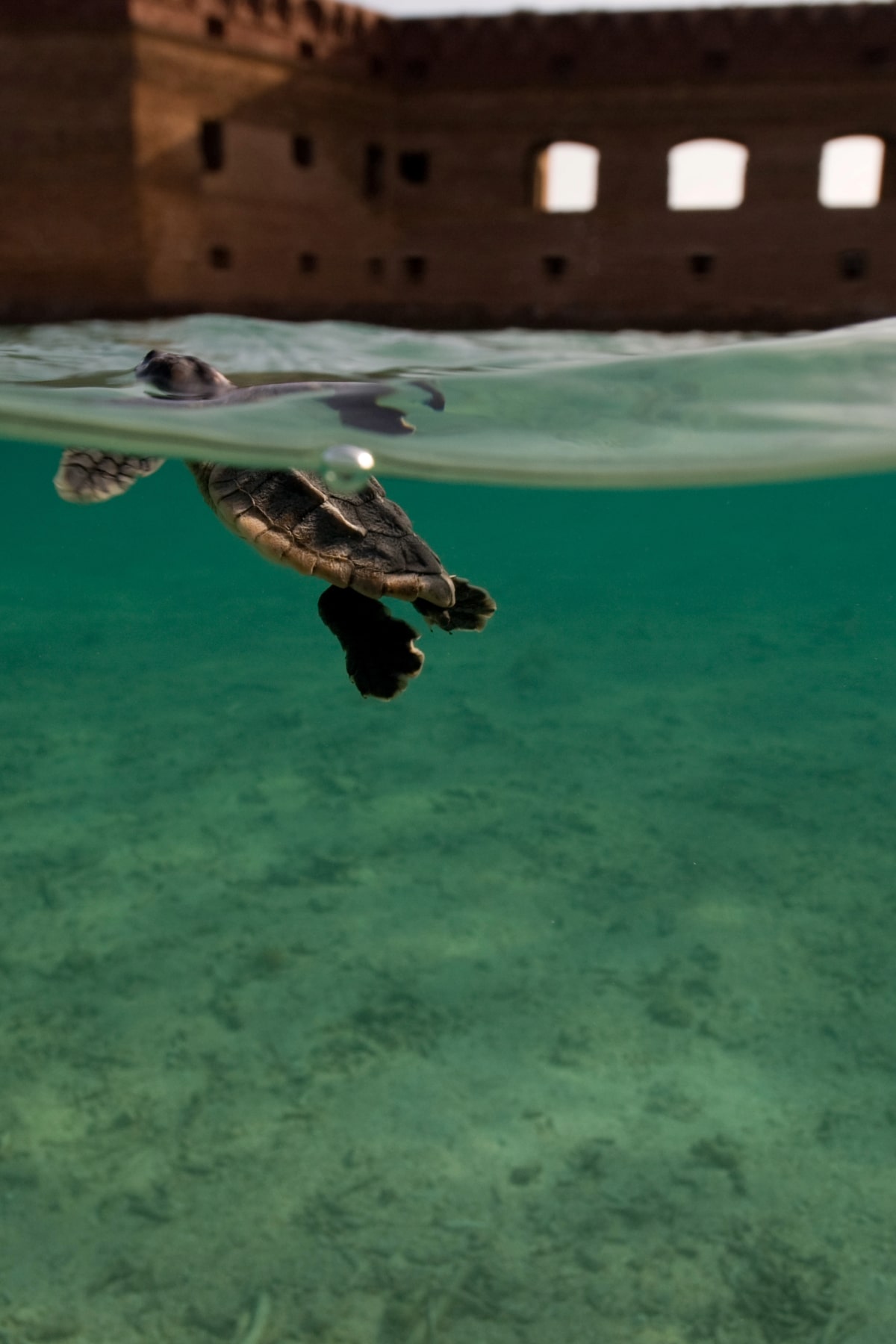
Map Of Things to Do in Dry Tortugas
Pin Dry Tortugas Snorkeling and Activities
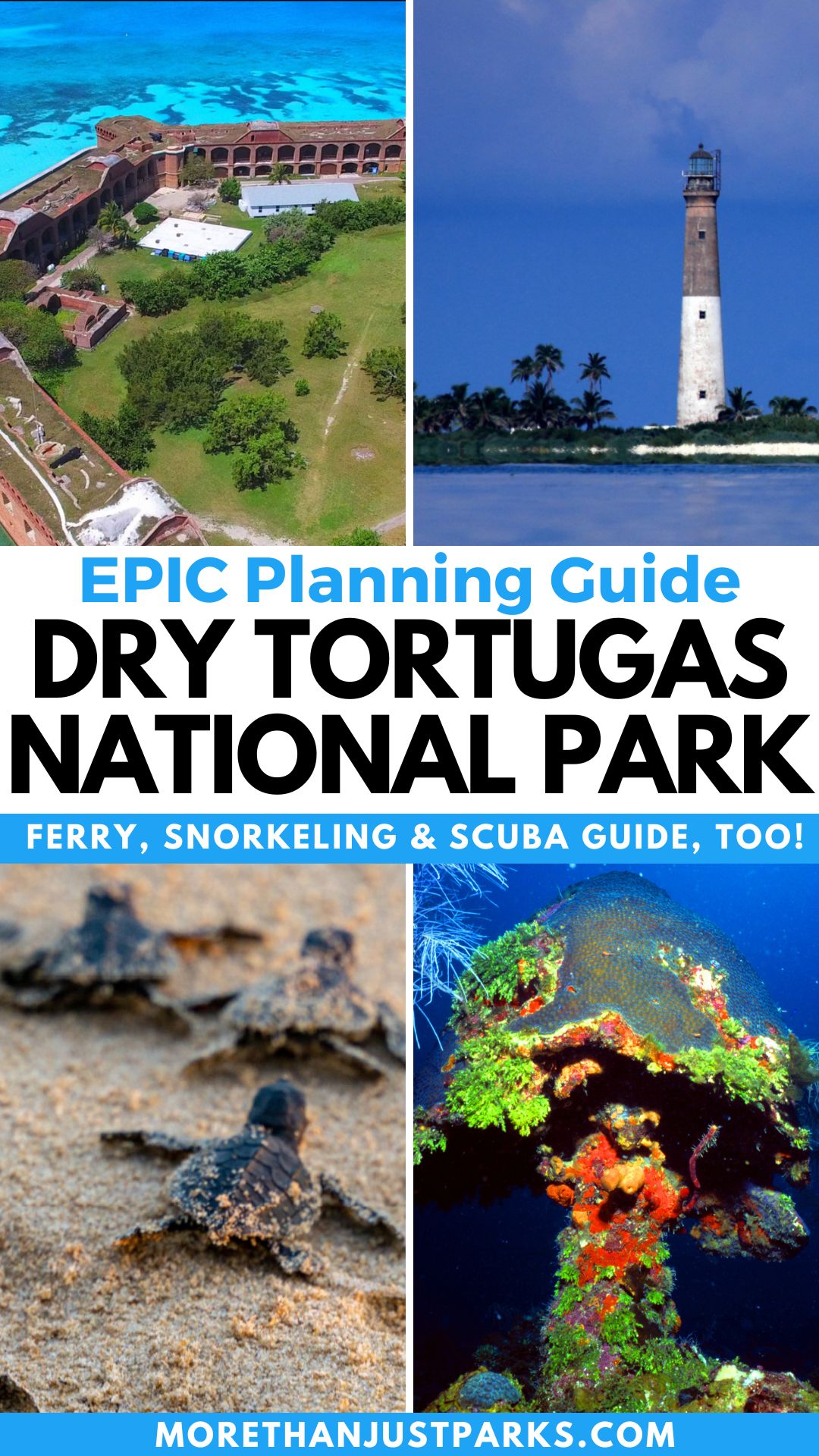

Helpful Related Links
More Florida National Parks: 11 EPIC Florida National Parks Worth Visiting (Expert Guide + Photos)
Overseas Highway Road Trip: Miami to Key West Drive: Everything You Need to Know
Florida National Parks: 11 Epic Florida National Parks Worth Visiting
Things to Do Biscayne: 15 Epic Things to Do in Biscayne National Park
Things to Do Everglades: 20 Epic Things to Do in Everglades National Park
National Parks Near Tampa: 9 Amazing National Parks Near Tampa
National Parks Near Miami: 5 Amazing National Parks Near Miami
Overseas Highway Road Trip: Miami to Key West Drive: Everything You Need to Know
Best East Coast National Parks: Top 10 Best East Coast National Parks Ranked
National Parks Ranked: ALL 63 US NATIONAL PARKS RANKED By Experts
Most Visited National Parks: Top 10 Most Visited US National Parks
Cheapest Cities to Live in Florida: 15 Cheapest Places to Live in Florida
Best Cities to Live in Florida: 15 Best Places to Live in Florida





Leave a Reply